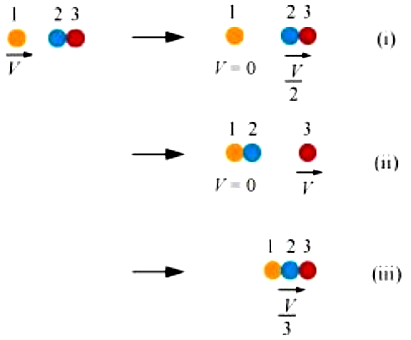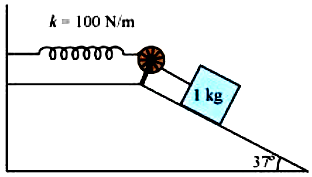Which one of the following statement is wrong?
1.
When a conservative force does positive work on a body, the potential energy of the body decreases.
2.
Work done by a body against friction always results in a loss of its kinetic energy.
3.
The rate of change of the total momentum of a many-particle system is proportional to the sum of the internal forces on the system.
4.
In an inelastic collision of two bodies, the total linear momentum of the system of two bodies does not change after the collision.
An electron and a proton are detected in a cosmic ray experiment, the first with kinetic energy \(10~\text{keV},\) and the second with \(100~\text{keV}.\) The ratio of their speeds is:
(take \(m_e=9.31\times 10^{-31}~\text{kg},\) \(m_p=1.67\times 10^{-27}~\text{kg},\) \(1~\text{eV}=1.60\times 10^{-19}~\text{kg}\) )
1. \(13.5: 1\)
2. \(1: 1\)
3. \(1: 13.5\)
4. \(2: 1\)
A raindrop of radius \(2~\text{mm}\) falls from a height of \(500~\text{m}\) above the ground. It falls with decreasing acceleration (due to viscous resistance of the air) until, at half its original height, it attains its maximum (terminal) speed, and moves with uniform speed thereafter. What is the work done by the gravitational force on the drop in the first and second half of its journey?
| 1. | \(0\) in each half | 2. | \(0.082~\text{J}\) in each half |
| 3. | \(17.87~\text{J}\) in each half | 4. | \(0.045~\text{J}\) in each half |
Two identical ball bearings in contact with each other and resting on a frictionless table are hit head-on by another ball bearing of the same mass moving initially with a speed V. If the collision is elastic, which of the following figure is a possible result after collision?

1. (i)
2. (ii)
3. (iii)
4. None of these.
The bob A of a pendulum released from 30° to the vertical hits another bob B of the same mass at rest on a table as shown in the figure. How high does bob A rise after the collision? Neglect the size of the bobs and assume the collision to be elastic.
1. Bob A will rise to a height of 0.01 m.
2. Bob A will rise to a height of 0.5 m.
3. Bob A will not rise at all.
4. Bob A will rise to a height of 0.3 m.
The bob of a pendulum is released from a horizontal position. If the length of the pendulum is \(1.5~\text m,\) what is the speed with which the bob arrives at the lowermost point, given that it dissipates \(5\%\) of its initial energy against air resistance?
1. \(2.5~\text{m/s}\)
2. \(3.9~\text{m/s}\)
3. \(4.7~\text{m/s}\)
4. \(5.3~\text{m/s}\)
A body of mass 0.5 kg travels in a straight line with velocity where . What is the work done by the net force during its displacement from x = 0 to x = 2 m?
1. 50 J
2. 45 J
3. 68 J
4. 90 J
A person trying to lose weight (dieter) lifts a \(10~\text{kg}\) mass, one thousand times, to a height of \(0.5~\text m\) each time. Assume that the potential energy lost each time she lowers the mass is dissipated. How much work does she do against the gravitational force?
1. \(29,000~\text J\)
2. \(49,000~\text J\)
3. \(21,000~\text J\)
4. \(18,000~\text J\)
1. \(180~\text{m}^2\)
2. \(150~\text{m}^2\)
3. \(200~\text{m}^2\)
4. \(300~\text{m}^2\)
A 1 kg block situated on a rough incline is connected to a spring of spring constant as shown in the figure. The block is released from rest with the spring in the unstretched position. The block moves 10 cm down the incline before coming to rest. The coefficient of friction between the block and the incline is:
(Assume that the spring has a negligible mass and the pulley is frictionless.)

1. 0.03
2. 0.14
3. 0.11
4. 0.08







